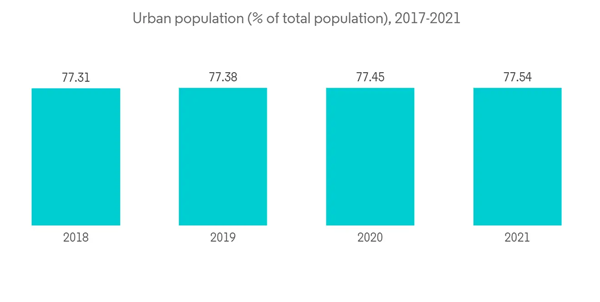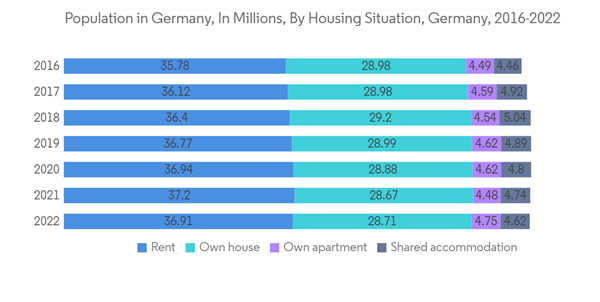Key Highlights
- One important demographic for manufactured homes is low-income households. Due to the COVID-19 pandemic and its restrictions in Germany, some low-income households have experienced job losses or reduced working hours. Typically, consumers who buy manufactured homes buy the house and rent the land. The availability of home-only financing has become more challenging for some lenders, which may have an impact on the demand for manufactured houses.
- In Germany, the epidemic has resulted in fewer sales for operators of manufactured home communities, but many believe that demand will pick up once lockdown restrictions are relaxed and more people start working again.
- Demand for manufactured housing is on the rise especially in the developing urban areas of Germany because manufactured homes provide benefits like reduced environmental impact and energy efficiency. Operational effectiveness and cheaper manufacturing costs are manufactured homes' main competitive advantages. These benefits result from the ability to apply standardized procedures in a regulated industrial setting, which decreases waste, gets rid of weather-related delays, and lowers the possibility of theft and vandalism.
- A centrally trained and supervised labor force that is more productive can be used by operators of manufactured housing, giving them greater flexibility and avoiding the challenges of managing a complicated web of paid contractors. Last but not least, manufactured home manufacturers have a cost advantage over materials and appliances thanks to procurement efficiency and volume. In general, manufactured homes cost about half as much per square foot as newly constructed homes on-site.
- Some of the primary challenges faced by the market in Germany are Land-Use Restrictions and Financing. Some of the recent technologies that are used in manufactured homes include built-in wireless connectivity, pop-up power strips, keyless entry, and NEST Thermostats.
Germany Manufactured Homes Market Trends
Rapid Urbanization in the Region is Driving the Market
According to the Industry Association, 78% of Germans would live in cities as of 2022. The main driver of German urbanization is industrial sector growth. At present, more people live in cities and urban areas in Germany than in the majority of other countries.Rapid transformational expansion in Berlin brings both opportunities and difficulties for urban development planning. To keep Berlin a viable and international metropolis, the city government is dedicated to a culture of engagement in controlling growth. Additionally, the sustainable growth of the city is supported by the Urban Development Concept Berlin 2030.
As long as there are more individuals employed in offices and service-related enterprises, the urban expansion will continue. The Berlin metropolitan region, which houses the largest port, the greatest industrial hub, the most significant center for office work, and the country's capital, is by far the largest of them.
The third-largest region in Germany, Frankfurt/Rhein-Main (FRM), is well-known for its international airport, financial industry, stock market, and high-tech sector. The core region has experienced significant job growth and in-migration, and it is economically successful. Frankfurt Main plays a significant role, but the area is polycentric with a complex network of peri-urban centers and excellent open space. In 2022, the city had 791,000 residents, making it Germany's fifth most populated city, and 2.3 million people will live there in the city's urban area.
Demand for Housing is increasing in Germany.
Germany is the most populous nation in Europe, and around half of its people rent their homes. It also boasts the continent's largest multifamily market. Multifamily investments have increased since the coronavirus (COVID-19) outbreak began. The value of deals for properties with at least 50 residential units peaked in the 12 months leading up to January 2022 at approximately 54 billion euros, more than twice the level of prior investment activity, according to Statista.Berlin is a reasonably affordable city to rent an apartment in when compared to other cities in Germany and Europe, making it a popular choice for young professionals and students. However, increasing rents and declining affordability have been upsetting tenants. Over 50% of Berliners supported the resocialization of housing held by firms owning 3,000 or more units, according to the results of a legally non-binding vote in 2021. In 2020, a rent freeze was briefly implemented before being found unlawful.
The evolution of the residential market and housing demand may be understood mostly through house prices, which are undoubtedly the most significant indication. The nominal housing price increased by nearly 14% between the third quarters of 2021 and 2022 in just one year. However, inflation has also been on the rise, so keeping this in account, the increase in housing prices was only 7%. Munich is renowned for having one of the most expensive housing markets in all of Germany.
Germany Manufactured Homes Industry Overview
Germany manufactured homes market is fairly fragmented with the presence of many international and few local players. Some of the prominent players in the market are. Potential residents are being attracted by a variety of market participants in the manufactured home sectors with their economical possibilities. They pledge to always maintain strict supervision over the off-site building process. Leading rivals in the market are modifying homes with their technical know-how to meet changing consumer tastes, particularly in the areas of flooring, cabinetry, and exterior finish.Additional Benefits:
- The market estimate (ME) sheet in Excel format
- 3 months of analyst support
This product will be delivered within 2 business days.
Table of Contents
Companies Mentioned (Partial List)
A selection of companies mentioned in this report includes, but is not limited to:
- Swietelsky AG
- DFH Group
- Portakabin
- HusCompagniet A/S
- ALHO Modular Buildings
- Daiwa House Modular Europe
- Karmod
- Hanse Haus
- Baufritz
- Fertighaus Weiss GmbH.*










